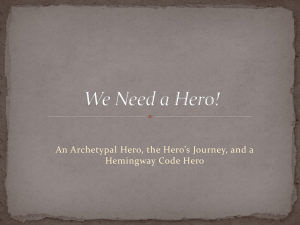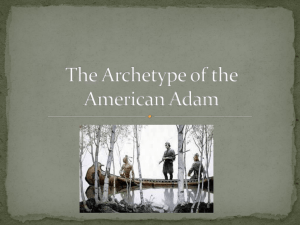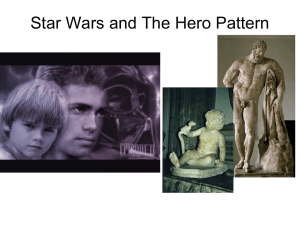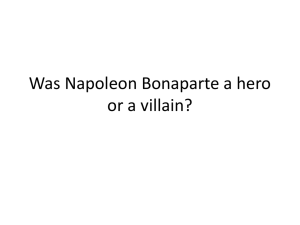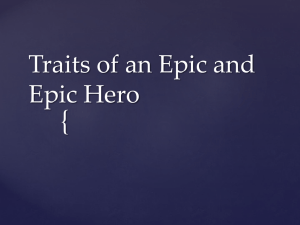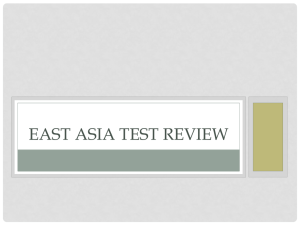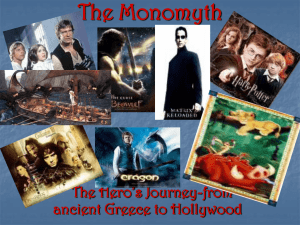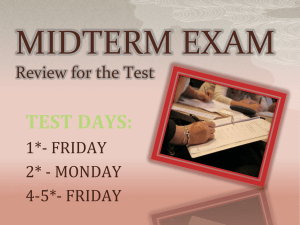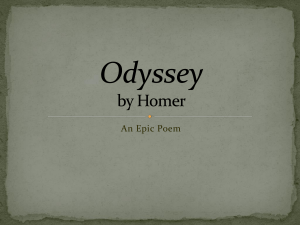The Archetypal Hero
advertisement
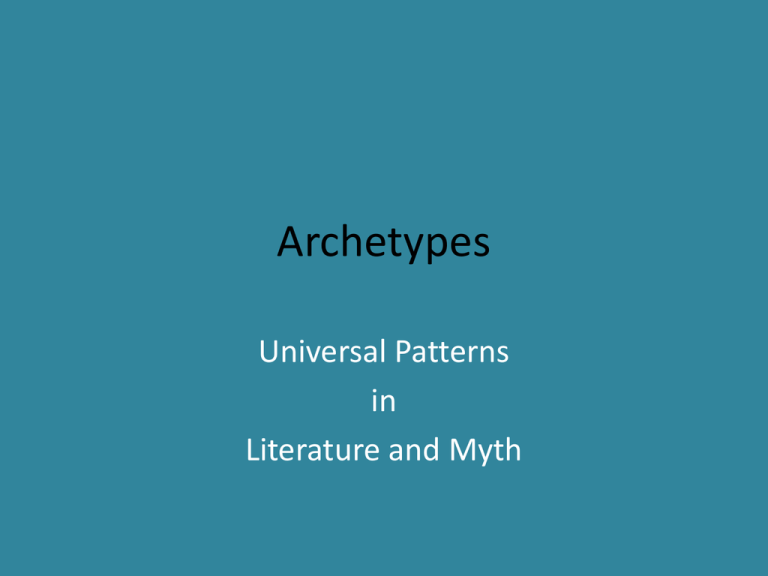
Archetypes Universal Patterns in Literature and Myth Why do we tell stories? • To help us escape reality by entering a world where the good guy wins, the forces of evil are defeated, and love conquers all. • To help define roles of “good” and “evil”; hero’s and villains so that we can better recognize those with similar morals and motives in our real lives. • Storytelling is essential for the survival of humanity and provides hope. • Stories connect us with our cultural and spiritual past. They help us understand many of our accepted traditions and rituals. • They allow us to tell our own stories to others and, using archetypes, help us better relate to the stories of others. The Archetypal Hero What Do Luke Skywalker, Simba, King Arthur, Moses, Wonder Woman, William Wallace, & Optimus Prime all have in common? ANSWER: They are all Archetypal Heroes But what is an Archetype? And what does it have to do with Heroes? What is an archetype? And what does it have to do with Heroes? A Simple Definition… • According to the American Heritage Online Dictionary…an archetype is an original model or type which other similar things are patterned after, in other words a prototype or first model for all others. Let’s start with the two guys who came up with the concept: Carl Jung Joseph Campbell • Carl Jung first applied the term archetype to literature. He recognized that there were universal patterns in all stories and mythologies regardless of culture or historical period and hypothesized that part of the human mind contained a collective unconscious shared by all members of the human species, a sort of universal, primal memory. • Joseph Campbell took Jung’s ideas and applied them to world mythologies. In A Hero with a Thousand Faces, among other works, he refined the concept of hero and the hero’s journey—George Lucas used Campbell’s writings to formulate the Star Wars saga. Recognizing archetypal patterns in literature brings patterns we all unconsciously respond to in similar ways to a conscious level. The term archetype can be applied to: • An image • An idea • A theme • A character type • A symbol • A plot pattern Archetypes can be expressed in • Myths • Religions • Dreams • Fantasies • Literature • Folklore Okay, so what exactly characterizes an Archetypal Hero then? CHARACTER ARCHETYPES • The Hero – In its simplest form, this character is the one ultimately who may fulfill a necessary task and who will restore fertility, harmony, and/or justice to a community. The hero character is the one who typically experiences an initiation, who goes the community’s ritual (s), et cetera. Heroic Archetypes • Hero as Warrior – A near god-like hero faces physical challenges and external enemies – Examples: Beowulf, Odysseus • Transcendent Hero – The hero of tragedy whose fatal flaw (hamartia) brings about his downfall, but not without achieving some kind of transforming realization of wisdom – Examples: Greek and Shakespearean tragedies – Oedipus, Hamlet, Macbeth, etc. Heroic Archetypes, cont. • Hero as Lover – A pure love motivates the hero to complete his quest – Examples: Prince Charming, Romeo • Romantic/Gothic Hero – Hero/lover with a decidedly dark side – Examples: Mr. Rochester in Jane Eyre • Apocalyptic Hero – Hero who faces the possible destruction of society http://www.handsomedevilpress.com/i/guys/G-021-prince-charming.jpg Heroic Archetypes, cont. • Proto-feminist Hero – Female hero, which differs from a heroine • A heroine usually exists as the object of a male quest • The female hero has her own journey – Overall movement is the same, but kinds of challenges, confrontations, goals and ends may differ. – Often fight against society’s expectations of them Heroic Archetypes, cont. • Anti-Hero – A non-hero, given the vocation of failure, frequently humorous – Example: Homer Simpson • Defiant Anti-Hero – Opposer of society’s definition of heroism/goodness – Example: Heart of Darkness http://l.yimg.com/img.tv.yahoo.com/tv/us/img/site/43/36/000003 4336_20061020191519.jpg Heroic Archetypes, cont. • Hero as Scapegoat – Hero suffers for the sake of others – Example: Jesus • Unbalanced hero – The protagonist who has (or must pretend to have) mental or emotional deficiencies – Examples: Hamlet, McMurphy in One Flew Over the Cuckoo’s Nest http://blog.afi.com/100movies/useruploads/post1338.jpg Heroic Archetypes, cont. • The Other – The Denied Hero – Protagonist whose status or essential otherness makes heroism possible – The outcast or member of a minority group – Example: Drizzt Do’Urden (Dark Elf Series), Invisible Man by Ralph Ellison Heroic Archetypes, cont. • The Superheroic http://images.art.com/images/-/Lou-Ferrigno--Hercules-Photograph-C10101949.jpeg – Exaggerates the normal proportions of humanity – Frequently has divine or supernatural origins. In some sense, the superhero is one apart, someone who does not quite belong, but who is nevertheless needed by society – Examples: • Mythological heroes such as – Hercules, – Superman http://www.watchingamerica.com/images/supe rman_pic.jpeg Traits of the Archetypal Hero • Unusual Circumstances of Birth • Leaves Family and Lives With Others • Traumatic Event Leads to Quest • Special Weapon • Supernatural Help Unusual Birth Often in danger or born into royalty… Leaves Family Raised away from… -or separated from home Traumatic Event The hero’s life is changed forever… Special Weapon Only the hero can wield it… Supernatural Help -The hero often has spiritual guidance More Heroic Traits… • Proves self on Quest • Journey and Unhealable Wound • Atonement With Father • Spiritual Apotheosis Proves Him or Herself The hero performs heroic feats… Journey & Unhealable Wound Hero descends into a helllike area and suffers wounding from an encounter with evil Atonement With Father The hero either redeems father’s evil deeds or reconciles with father over wrongs done by the hero Apotheosis Hero is rewarded spiritually at the end of his, or her life Types of Archetypal Journeys • • • • • • • • • • The quest for identity The epic journey to find the promised land/to found the good city The quest for vengeance The warrior’s journey to save his people The search for love (to rescue the princess/damsel in distress) The journey in search of knowledge The tragic quest: penance or self-denial The fool’s errand The quest to rid the land of danger The grail quest (the quest for human perfection) The Hero’s Journey • Stage 1 - Departure: The hero is called to adventure, although he is reluctant to accept. • Stage 2 - Initiation: The hero crosses a threshold into a new, more dangerous world, gaining a more mature perspective. • Stage 3 - The Road of Trials: The hero is given supernatural aid, endures tests of strength, resourcefulness, and endurance. • Stage 4 - The Innermost Cave: The hero descends into the innermost cave, an underworld, or some other place of great trial. Sometimes this place can be within the hero’s own mind. Because of this trial, the hero is reborn in some way—physically, emotionally, or spiritually. Through this experience, the hero changes internally. • Stage 5 - Return and Reintegration with Society: The hero uses his new wisdom to restore fertility and order to the land Characteristics of the Hero’s Journey • • • • • • • • The hero is naïve and inexperienced The hero meets monsters or monstrous men The hero has a strange, wise being as a mentor The hero years for the beautiful lady who is sometimes his guide or inspiration The hero must go on a journey, learn a lesson, change in some way, and return home The hero often crosses a body of water or travels on a bridge. The hero is born and raised in a rural setting away from cities The origin of the hero is mysterious or the hero losses his/her parents at a young age, being raised by animals or a wise guardian Characteristics of the Hero’s Journey • • • • • • • • • • • The hero returns to the land of his/her birth in disguise or as an unknown The hero is special, one of a kind. He/she might represent a whole nation or culture The hero struggles for something valuable and important The hero has help from divine or supernatural forces The hero has a guide or guides The hero goes through a rite of passage or initiation, an event that marks a change from an immature to a more mature understanding of the world The hero undergoes some type of ritual or ceremony after his/her initiation The hero has a loyal band of companions The hero makes a stirring speech to his/her companions The hero engages in tests or contests of strength (physical and/or mental) and shows pride in his/her excellence The hero suffers an unhealable wound, sometimes an emotional or spiritual wound from which the hero never completely recovers. • Anti-Hero-is generally considered to be a protagonist whose personality can be perceived as being villainous and heroic together, or doesn’t embody the more noble characteristics of an archetypal hero. Other Archetype Characters • Young Person from the Provinces – This hero is taken away as an infant or youth and raised by strangers. He or she later returns home as a stranger and able to recognize new problems and new solutions. Hunting Group of Companions Hunting Group of Companions – These loyal companions are willing to face any number of perils in order to be together. Loyal Retainers These individuals are like the noble sidekicks to the hero. Their duty is to protect the hero. Often the retainer reflects the hero’s nobility. • The Initiates – These are young heroes who, prior to the quest, must endure some training and ritual. They are usually innocent at this stage. • Mentors – These individuals serve as teachers or counselors to the initiates. Sometimes they work as role models and often serve asas father or mother figure. They teach by example the skills necessary to survive the journey and quest. • The Scapegoat – An animal or more usually a human whose death, often in a public ceremony, excuses some traitor sin that has been visited upon the community. This death often makes theme more powerful force to the hero. • The Outcast – This figure is banished from a community for some crime (real or imagined). The outcast is usually destined to become a wanderer. • The Devil Figure – This character represents evil incarnate. He or she may offer worldly goods, fame, or knowledge to the protagonist in exchange for possession of the soul or integrity. This figure’s main aim is to oppose the hero in his or her quest. Women (Other than Heroines, of course) – The Temptress – Characterized by sensuous beauty, she is one whose physical attraction may bring about the hero’s downfall. The Damsel in Distress – This vulnerable woman must be rescued by the hero. She also may be used as a trap,by an evil figure, to ensnare the hero. The Platonic Ideal – This source of inspiration often is a physical and spiritual ideal for whom the hero has an intellectual rather than physical attraction. The Earth Mother – This character is symbolic of fulfillment, abundance, and fertility; offers spiritual andemotional nourishment to those who she contacts; often depicted in earth colors. Star-Crossed lovers • THE STAR-CROSSED LOVERS. A young man and woman enter an ill-fated love affair which ends tragically in the death of either or both of the lovers Animals – Friendly Beast –These animals assist the hero and reflect that nature is on the hero’s side. The Creature of Nightmare – This monster, physical or abstract, is summoned from the deepest, darkest parts of the human psyche to threaten the lives of the hero/heroine. Often it is a perversion or desecration of the human body. The Evil Figure with the Ultimately Good Heart – This redeemable devil figure (or servant to the devil figure) is saved by the hero’s nobility or good heart. Colors as Symbolic Archetypes • Black (darkness) – chaos, mystery, the unknown, before existence, death, the unconscious, evil • Red – blood, sacrifice, violent passion, disorder, sunrise, birth, fire, emotion, wounds, sentiment, mother, Mars, anger, excitement, heat • Green – hope, growth, envy, Earth, fertility, sensation, vegetation, nature, greed. • White (light) – purity, peace, innocence, goodness, Spirit, morality, creative force, the direction East, spiritual thought. • Orange – fire, pride, ambition, egoism, Venus • Blue – clear sky, the day, the sea, height, depth, heaven, religious feeling, devotion, innocence, truth, spirituality. • Violet – Royality, nostalgia, memory, advanced spirituality, Neptune. • Gold – Majesty, sun, wealth, Other Common archetypes: • • • • • • • • • • • • • • Meals together tend to be acts of communion/community or isolation. Ghosts, vampires, monsters, and nasty people and sometimes simply the antagonists are not about supernatural brew-ha-ha; they tend to depict some sort of exploitation. There’s only one story. Look for allusions and archetypes. Weather matters. Violence and be both literal and figurative. Symbols can be objects, images, events, and actions. Sometimes a story is meant to change us, the readers, and through us change society. Flying tends to represent freedom. What do you think falling represents? Geography tends to be a metaphor for the psyche. (deserts, cliffs, oceans, etc.) Seasons tend to be traditional symbols. Disabilities, Scars, and Deformities show character and theme. Heart disease tends to represent problems with character and society. So do illness and disease. Read with your imagination. Irony trumps everything!
